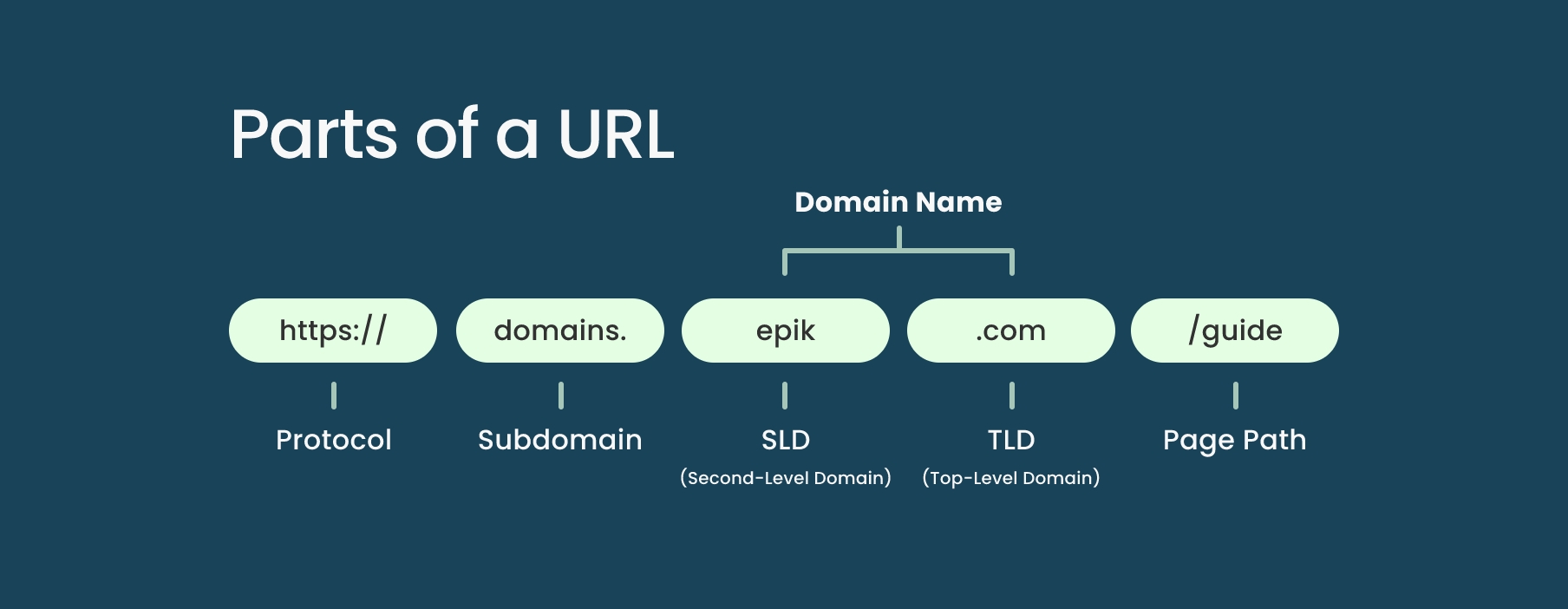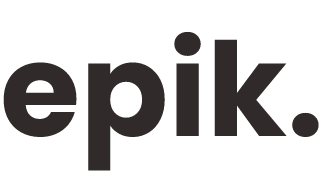Your guide to domain names

The essential facts about domains
Understanding domain names can feel overwhelming—where should you start, and how do you pick the right one? If you’re launching a new business, promoting your organization, or building your online brand, knowing how to get the best domain name is time well-invested. This guide breaks down everything you need to know about domains, from understanding extensions like .com and .app to finding out who owns a domain you really want.
With our expert advice, you’ll save time, avoid pitfalls, and secure a domain that will make your brand stand out. Ready to simplify the process? Let’s dive in.
What is a domain name?
A domain name is the address of a website, like epik.com. It allows potential clients, customers, or readers to find you online. Domain names are a key part of the internet’s infrastructure, acting as your direct connection to the online world. They’re not just practical; they’re your website’s face and identity. And a great domain name can help draw in visitors, drive traffic, and even grow your audience by making it easier for people to remember and return to your site.
Think of it like the street address for your home: when people want to visit you, they don’t need to know the exact global coordinates, just your street name and house number. Similarly, when people want to visit your website, they don’t need to know your IP address, they just need to know your domain name.
Why you need a great domain name
Registering a solid domain is crucial when establishing an online presence. A great website will help sell a product or get you hired, and a great domain name is how people will find it. We’ve been talking about how a domain name is like the street address for a website, but here’s the key difference: you get to choose your domain name. This gives you extra control over your brand, helping you stand out in the crowded digital world.
While some visitors will find your site through links or bookmarks, the right domain can:
- Attract new traffic, especially if it’s short, memorable, and easy to share.
- Improve your SEO rankings, boosting your website’s visibility in search results.
- Build trust and credibility by showcasing your professionalism and legitimacy.
- Enable professional, branded email addresses that leave a lasting impression.
- Future-proof your brand and signal to the world that you’re open for business.
The parts of a domain name
A domain name consists of two key parts: the top-level domain (TLD) and the second-level domain (SLD). For instance, in the domain name CatCafe.com, “.com” is the top-level domain and “CatCafe” is the second-level domain. Together, these two elements help browsers quickly locate the homepage of any website and they create a unique, easy to remember web address that can help users find it.
Think of it again like a street address:
- Just as “123 Main Street” includes both the street number and street name, a domain has both a TLD (which directs your browser to the right place on the web) and SLD (which pinpoints an exact site).
- Just like there can be both “123 Main Street” and “123 Pecan Street,” CatCafe.com and CatCafe.org can both exist at the same time.

Is a domain name the same as a URL?
Even though these words “domain” and “URL” are often used interchangeably, the terms technically refer to different things. Domain names are often just one part of a longer string of characters called a URL (Uniform Resource Locator).
These extra pieces of information, like subdomains and subdirectories, can tell your browser how to access a website or what area of the site to navigate to. Using our street address analogy, a subdomain (blog.CatCafe.com) is like a separate building at the address, while a subdirectory (CatCafe.com/blog) is like a specific floor inside the main building.
What is a TLD?
A TLD, or top-level domain, is the part of a domain name that comes after the last dot, like “.com,” “.org,” or “.net.” These are also known as domain extensions, or just extensions. Choosing the right TLD can impact what people think of a website and can even improve a site’s searchability and relevance. The most common TLDs can usually be used by anyone, but it’s good to know your options if you’re interested in attracting a more niche audience.
gTLDs
A gTLD, or generic top-level domain, is an extension that can be used by anyone. Examples include the classics like .com and .net and newer ones like .blog, .shop, and .gallery. These offer the ability to choose an extension that represents a specific industry or purpose and can help a domain name stand out.
ccTLDs
A ccTLD, or country-code top-level domain, is an extension that represents a specific country or geographic area. It’s made up of two letters, like .uk for the United Kingdom, .de for Germany, or .ca for Canada. These country-specific domains will help target a particular region or audience, letting visitors know that a site is relevant to them.
sTLD
An sTLD (sponsored top-level domain) is a type of top-level domain that is restricted to specific communities or industries. Some examples include .edu, which is restricted to accredited educational institutions, and .gov, which is reserved for U.S. government organizations. The checks and restrictions on these extensions ensure that they’re trustworthy within their fields.
Popular TLDs
The right TLD can shape a site’s focus, attract the right audience, and help you stand out. Think about all the possibilities and see what’s popular in your industry. Here are some of the most popular TLDs to get started.
How domain registration works
Domain names are what make the internet user-friendly. Instead of memorizing a series of numbers (IP addresses) to visit a website, we can use easy-to-remember names, like google.com. This simple system is thanks to the Domain Name System (DNS), which works behind the scenes to make sure everything functions smoothly.
Think of the DNS like the internet’s phonebook. When you type in a domain name, the DNS translates it into an IP address that computers use to find the server hosting the website. This is what allows a browser to connect users to the right site, even though they’re using a simple, human-readable name.
To secure a domain, you’ll need to register it through a domain registrar (like Epik!), which manages domain availability and helps connect a domain to the website’s server. While registrars don’t directly change the DNS system, they let domain owners update nameservers to control where a domain points, guiding the internet to the right site.
Once registered, a domain is linked to the owner’s contact details, stored in a public database called WHOIS, allowing others to look up domain ownership. However, if you want to keep your information private (and most people do), good registrars offer domain privacy services to protect your contact details from being publicly visible.
The domain registration system is overseen by ICANN (the Internet Corporation for Assigned Names and Numbers), a global organization that ensures everything runs smoothly. ICANN manages domain extensions (.com, .org, etc.) and enforces rules for domain registration, making the process fair and organized across the globe.
With the DNS, domain registrars, WHOIS, and ICANN working in harmony, domain names make it easy for us to find the information we need online. These systems ensure that when someone registers a domain, it’s connected to the right place and accessible to everyone who wants to find it.
Want to learn more?
What is ICANN?
Read More

What is a domain registrar?
Read More

What is domain forwarding?
Read More

to The epik Blog >
How to choose a domain name
A domain name is more than just a digital address, it’s the key to being found online. If people can’t find your website, they can’t see your portfolio, book your services, or find your contact info. Every website is different, and while you’re the best judge about what your brand or business needs, it doesn’t hurt to have some guidance.
We have a thorough, detailed guide on choosing a domain, so we won’t repeat ourselves here. This quick guide helps you choose a domain name with simple tips to get started and smart fixes for common challenges, including how to choose the right TLD, how to find out if your first choice is available, and how to avoid potential legal issues. The thing we stress the most is to take your time and do your research. With the right approach and a clear plan, your perfect domain is just a few steps away.
Have other questions? We have answers to those, too! Wondering if you need to use a .com? Seeking the perfect extension for your nonprofit? Let us help you claim the domain that fits your vision.
Picking a registrar
Choosing the right domain registrar is an important step in building an online presence. Do not go with the cheapest registrar that appears—a reputable registrar will have the tools, support, and reliability needed to make your website a success. Picking wisely now can save time and hassle down the road.
Look for a registrar that offers free WHOIS protection, which keeps personal information hidden from the public domain registry. SSL certificates are another important feature, as they secure websites and build trust with visitors.
Look for a registrar with clear, upfront pricing. Be wary of registrars that offer low initial prices only to surprise you with high renewal rates. And make sure the registrar clearly outlines costs for registration, renewal, and transfers, so you know exactly what you’re paying for.
When selecting a domain registrar, choose one that offers more than just domain registration. Look for a provider that can serve as your brand’s headquarters, with additional services like email, reliable hosting, and phone numbers with your preferred area code.
Whether you’re setting up your domain, facing a technical issue, or just need advice, it’s nice to have real people available at any time. Look for a domain registrar that offers live customer support around the clock so you’re never left to figure things out on your own.
A good registrar gives the flexibility to choose the best hosting plan for your needs, without locking you into one provider. You should be able to transfer your domain and your website wherever you like, whenever you like.
Watch & learn: registering your domain
Want a quick walkthrough for setting up your first domain name? Watch this short video to see exactly how to register a domain with us, step by step.
If you prefer a written guide you can reference whenever, check out the simple steps below to secure your perfect domain name today.
How to register a domain
Getting a domain name is quick and easy! Once you’ve chosen the right domain registrar, follow these steps:
1
Use our domain name search tool for instant availability results on your preferred web address (and variations).
2
If your chosen domain is already taken by someone, try making changes your SLD or TLD, or check WHOIS to see who owns the domain.
3
If your domain is available, great! Simply select it and head to checkout.
4
During checkout, opt-in to WHOIS domain privacy if you don’t want your contact information to be publicly visible.
5
Take a look at any extra services your registrar offers, such as hosting, security, or business tools. And enable auto-renew if you want to ensure your domain is always yours.
Wondering what to do after your domain name is secured? Check out our post on what to do next once you have the domain of your dreams.
FAQ
A domain name usually runs you about $10 to $20 a year for a standard .com. But if you’re after something super rare or trendy (like one-word domains), you might be looking at a few hundred—or even thousands. Some registrars sweeten the deal with discounts for your first year, but heads up: renewal prices are often higher. Pro tip: always check those renewal rates before clicking “buy.”
Absolutely! You can register as many domain names as your heart (or business plan) desires. Whether you want to cover all the variations of your brand name, lock down different extensions like .com and .net, or snag some creative ideas for future projects, there’s no limit. Just remember: every domain has its own yearly price tag, so keep an eye on your budget if you’re building your domain empire.
An SSL certificate is like a digital security badge for your website. It encrypts the data traveling between your site and your visitors, keeping sensitive info like passwords and credit card details safe from prying eyes. You know that little padlock icon next to a web address? That’s the SSL certificate at work, proving your site is secure. It’s also a trust booster—search engines love it, and your visitors will too.
DNS stands for Domain Name System, but think of it as the internet’s phonebook. It takes the easy-to-remember domain name you type in and translates it into the actual IP address (a string of numbers) that computers use to find websites. Without DNS, we’d all have to remember those long, boring IP addresses. It’s what makes the internet user-friendly, letting you get where you need to go without breaking a sweat.
Domain forwarding is like setting up a mail forwarding address—but for websites. When someone types in one domain name, it automatically sends them to another. For example, if you own both yourcoolbusiness.com and yourcoolbusiness.net, you can forward the .net domain to the .com one, so all your traffic lands in the same place. It’s super handy for keeping things simple for your visitors and making sure you don’t miss out on any clicks.
Your domain registration lasts as long as you pay for it—typically one to ten years at a time, depending on what you choose when you register. You’ll need to renew it before it expires to keep it under your control. If you forget to renew, you risk losing it, and someone else might scoop it up. We always suggest setting up auto-renewal so you don’t have to think about it!
Renewing your domain name is a breeze. Just log in to your domain registrar account, find the domain you want to renew, and follow the steps to extend your registration. You can usually renew for one year or multiple years at once, depending on your plan. To make life even easier, most registrars (Epik included) offer auto-renewal—just turn it on, and your domain will stay yours without lifting a finger.
If your domain name expires and you don’t renew it, you’ll lose control of it. But don’t panic just yet! Most registrars give you a grace period (usually around 30 days) to renew it without extra fees. After that, it enters a “redemption period” where it’s still possible to get it back, but it can cost you more. If you let it go too long, the domain may be released and available for someone else to register. So, it’s best to renew before it expires!
ICANN (Internet Corporation for Assigned Names and Numbers) is like the internet’s rulebook keeper. It’s a nonprofit organization that manages and coordinates domain names, making sure everything runs smoothly. ICANN oversees the system that turns domain names into IP addresses, handles domain name extensions like .com and .org, and ensures there’s no confusion or overlap. In short, they keep the internet organized so we don’t end up with multiple websites fighting over the same name.
WHOIS is like the public directory for domain names. It’s a database that stores information about who owns a domain, including contact details like name, email, and phone number. When you search WHOIS, you can find out who registered a specific domain, along with other technical details. While most of this info is visible to anyone, some people choose to use privacy protection services to keep their personal details hidden from the public.
Still Have Questions?
Ready to get started or have questions? Give us a call anytime at (737) 301-5923. Our team of friendly support experts is here 24/7, ready to guide you through choosing the perfect domain name, getting your site up and running, or making your first sale. Let’s make your next big idea a reality—reach out today!











